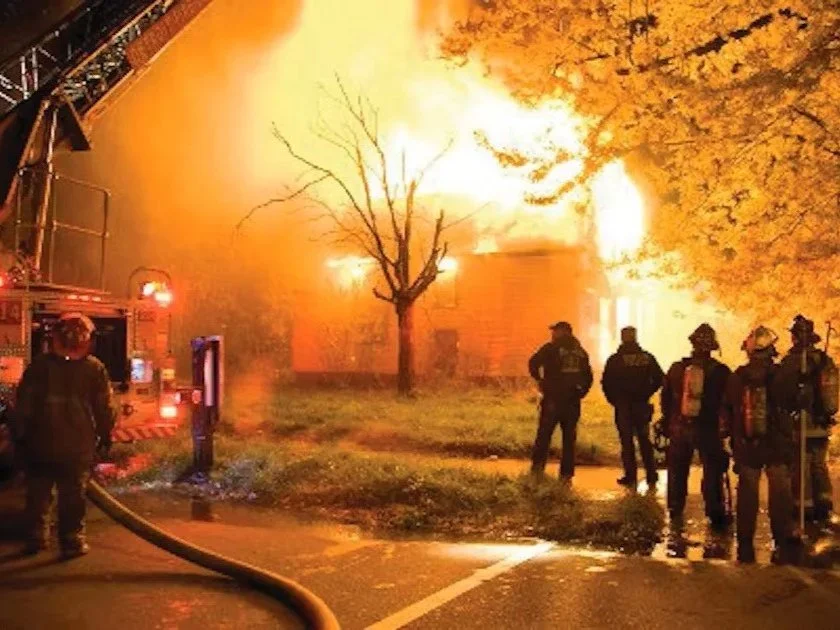Devil’s Night in Detroit
Detroit firefighters battle a blaze on Pennsylvania and Sylvester on October 31, 2010.
A haunted history of fire, fear, and community resilience
By Jenna Abroo
Many people associate October with classic fall traditions such as visiting pumpkin patches, picking apples, enjoying cider and donuts, or preparing for Halloween. These American family customs trace back more than 200 years, with roots in Scottish and Irish immigrant culture.
But the history of Halloween also includes a lesser-known tradition unique to Metro Detroit: Devil’s Night. Observed every October 30, the night before Halloween is infamous for its chaos. It even inspired the comic book that became the feature film The Crow.
Devil’s Night originated from “Mischief Night” in Europe, particularly in Great Britain, where young people would play harmless pranks and indulge in lighthearted mischief. So how did this playful tradition evolve into one of the darker chapters of Detroit’s history?
Children in the United States have celebrated Halloween since the 1800s, but “Devil’s Night” did not take root in America until the mid-20th century. What began as harmless pranks—such as toilet-papering houses, egging cars and soaping windows—evolved into dangerous acts of arson and vandalism across Detroit.
By the 1970s, the playful mischief of Devil’s Night had escalated into widespread violence. Arson, property destruction and unchecked crime ran rampant through the city. Detroit’s hundreds of abandoned houses, warehouses and commercial properties became easy fuel for the flames. In a city already struggling with economic decline and community decay, the destruction only deepened the sense of disorder.
The violence peaked in the 1980s. On October 30, 1984, as many as 800 houses and cars were burned in a single night, leaving behind injuries and even deaths. With police and fire departments underfunded and understaffed, authorities struggled to contain the chaos.
Devil’s Night continued its grip on Detroit throughout the 1980s and 1990s. In an effort to regain control, the city enacted a curfew in 1986, barring anyone under 18 from being out past 10 p.m. without an accompanying adult, including during the days leading up to October 30. For many in Detroit, the destruction of Devil’s Night became a stark reminder of the violence that defined the city during that era.
By the mid-1990s, Detroit launched massive efforts to clean up the streets and keep residents safe in the days leading up to Devil’s Night and Halloween. In 1995, Mayor Dennis W. Archer introduced “Angel’s Night,” a community-led initiative designed to combat the city’s widespread arson and vandalism during that period.
Thousands of volunteers took to the streets with flashlights and radios to help prevent fires and other crimes. Residents also did their part at home by keeping porch lights on and even attaching amber lights to their cars to deter vandals and arsonists.
These grassroots efforts had a dramatic effect. Crime decreased steadily over the next decade, and by 2010, incidents had dropped significantly. With the tradition largely under control, the city officially retired Angel’s Night in 2017.
In its place, Detroit shifted its focus to family-friendly celebrations under the banner of “Halloween in the D,” honoring the spirit of community involvement and safety that helped restore order. Even today, many residents pay tribute to the Angel’s Night era by turning on their porch lights and keeping watch over their neighborhoods, a lasting symbol of resilience and unity.
Many people in metro Detroit remember the height of destruction that once plagued the city in the days leading up to Halloween. But the progression of that history also reveals the strength of Detroit’s close-knit community. In the face of violence and unrest, residents came together to protect families and restore a sense of safety.
While the dark legacy of Devil’s Night will always remain part of Detroit’s past, recent years highlight a brighter future. October 30 is once again just the night before Halloween—a reminder of the city’s resilience and its ability to turn darkness into light.
Today, as Detroit continues to embrace community and safety, families can enjoy Halloween festivities without fear. From neighborhood trunk-or-treats to local community events, the city offers plenty of opportunities for children to celebrate in a fun and secure environment.
Trunk or Treat Activities in Metro Detroit 2025
KW Lakeside
Saturday October 11
12:00pm-3:00pm
45609 Village Boulevard
Shelby Township, MI 48315
Willow Greenhouse
Saturday October 11
2:00pm-4:00pm
7839 Curtis Road,
Northville, MI 48168
Thrive Realty Co.
Tuesday October 21
5:00pm-7:00pm
880 W Long Lake Road
Troy, MI 48098
Troy Police Department
Tuesday October 23
5:00pm-8:00pm
500 West Big Beaver Road,
Troy, MI 48084
First Church
Saturday October 25
39400 Dequindre Rd,
Sterling Heights, MI 48310-1705
Chaldean Community Foundation
Tuesday October 28
4:30pm-7:00pm
2075 Walnut Lake Road,
West Bloomfield
Mercy Education Project
Thursday October 30
5:00pm-7:00pm
450 Howard Street
Detroit, MI 48216

